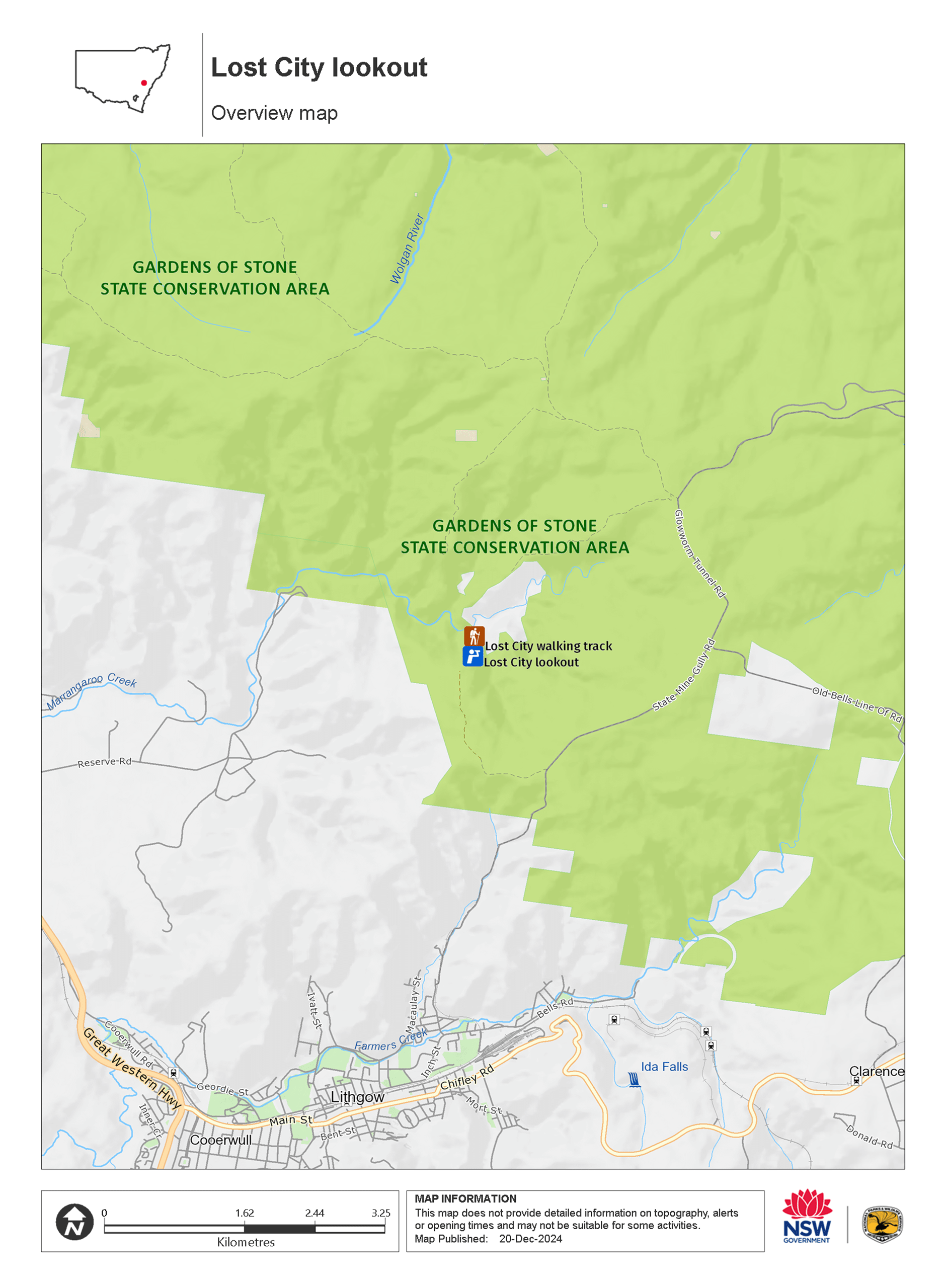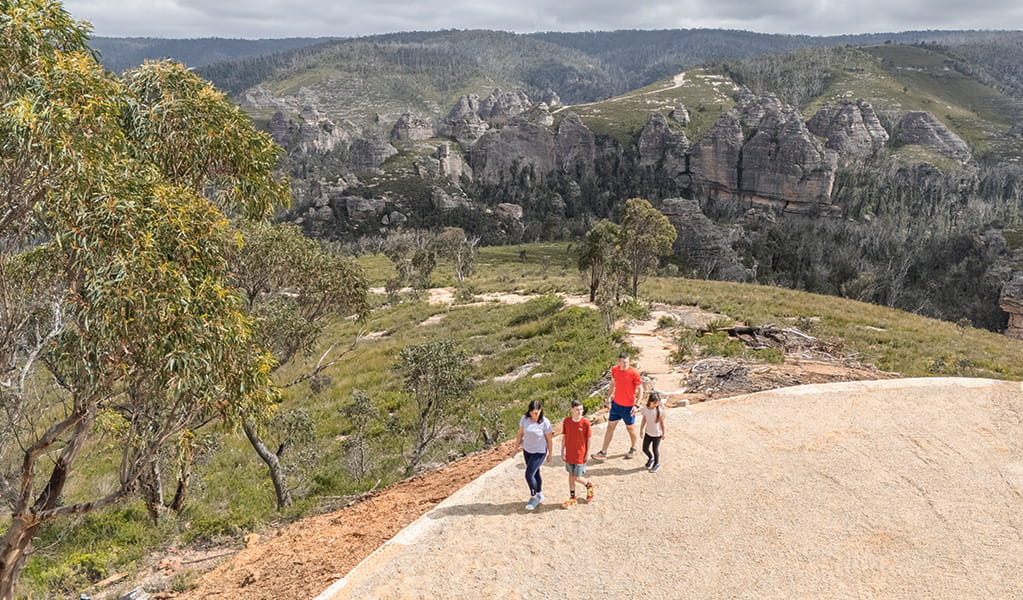Lost City lookout
Gardens of Stone State Conservation Area
Overview
Lost City lookout is the gateway to Lost City walking track near Lithgow. It’s a scenic spot for a picnic with views of unique ‘platy’ pagoda rock formations and the sandstone escarpment as a backdrop.
Overlooking Marrangaroo Creek in Gardens of Stone State Conservation Area, Lost City lookout offers one of the best vantage points in the park. With picnic tables and benches just 400m from the carpark, the lookout is a great picnic spot for visitors.
To see more of the area on foot, take the family-friendly Lost City walking track that starts from the lookout. This memorable 6km return walk takes about 2-4hrs and includes creek crossings, magnificent views, and heritage mining relics.
Nearby
-

Lost City walking track
Lost City walking track is a family-friendly 6km return walk in Gardens of Stone State Conservation Area. Just 5km from Lithgow, you'll see unique rock formations named pagodas, panoramic views, tranquil creeks and historic mining relics.
These maps give a basic overview of park attractions and facilities, and may not be detailed enough for some activities. We recommend that you buy a topographic map before you go exploring.
Map

Map legend

Local alerts
For the latest updates on fires, closures and other alerts in this area, see https://www.nationalparks.nsw.gov.au/things-to-do/lookouts/lost-city-lookout/local-alerts
Park info
- in Gardens of Stone State Conservation Area in the Sydney and surrounds region
Gardens of Stone State Conservation Area is always open but may have to close at times due to poor weather or fire danger.
Visitor info
All the practical information you need to know about Lost City lookout.
Maps and downloads
Learn more
Lost City lookout is in Gardens of Stone State Conservation Area. Here are just some of the reasons why this park is special:
Aboriginal culture

Gardens of Stone State Conservation Area is on Wiradjuri Country. This cultural landscape has many sites and artefacts like rock art, grinding grooves, wells, rock shelters and artefact scatters. The park adjoins Maiyingu Marragu Aboriginal Place – a well known rock art site and cultural education area. This location has great value to Wiradjuri People, who hold a deep connection with the land and a strong sense of custodianship to protect and preserve sites, plants and animals who call it home.
Unique environments

Perched swamps are important to the Newnes Plateau and are significant ecosystems as they feed into deep gullies, creeks and the headwaters the Wolgan, Coxs and Wollangambe rivers. The area also protects the Endangered Ecological Communities of Newnes Plateau and Shrub Swamps, Montane Peatlands and Swamps.
- Lost City walking track Lost City walking track is a family-friendly 6km return walk in Gardens of Stone State Conservation Area. Just 5km from Lithgow, you'll see unique rock formations named pagodas, panoramic views, tranquil creeks and historic mining relics.
Cultural heritage

Newnes and its surrounds was home to a thriving shale oil mining industry in the early 1900s. There are remarkably well-preserved remnants of the area’s mining history like dams, mine shafts and hand-carved stone steps.
- Lost City walking track Lost City walking track is a family-friendly 6km return walk in Gardens of Stone State Conservation Area. Just 5km from Lithgow, you'll see unique rock formations named pagodas, panoramic views, tranquil creeks and historic mining relics.
Striking geology

Geological activity has created a landscape of Triassic Narrabeen sandstone cliffs, slot canyons, gorges, caves, grand mesas, sandstone pinnacles and pagodas. These ‘platy’ pagodas have distinctive ironstone banding and are nationally significant because of their rarity. They can be as tall as 60m and are one of the many striking rock features to see in this geologically diverse park.
- Lost City walking track Lost City walking track is a family-friendly 6km return walk in Gardens of Stone State Conservation Area. Just 5km from Lithgow, you'll see unique rock formations named pagodas, panoramic views, tranquil creeks and historic mining relics.
Outdoor escapes

Enjoy a peaceful picnic, family-friendly walk or thrilling ride in spectacular natural surrounds. Existing adventure tracks are a drawcard for cyclists and 4WD enthusiasts while new visitor facilities provide improved access and a broader range of outdoor activities.
Plants and animals protected in this park
Animals
-

Bare-nosed wombat (Vombatus ursinus)
A large, squat marsupial, the Australian bare-nosed wombat is a burrowing mammal found in coastal forests and mountain ranges across NSW and Victoria. The only other remaining species of wombat in NSW, the endangered southern hairy-nosed wombat, was considered extinct until relatively recently.
-

Yellow-tailed black cockatoo (Calyptorhynchus funereus)
The yellow-tailed black cockatoo is one of the largest species of parrot. With dusty-black plumage, they have a yellow tail and cheek patch. They’re easily spotted while bird watching, as they feed on seeds in native forests and pine plantations.
-

Koala (Phascolarctos cinereus)
One of the most renowned Australian animals, the tree-dwelling marsupial koala can be found in gum tree forests and woodlands across eastern NSW, Victoria and Queensland, as well as in isolated regions in South Australia. With a vice-like grip, this perhaps most iconic but endangered Australian animal lives in tall eucalypts within a home range of several hectares.
Plants
-

Flannel flower (Actinotus helianthi)
The delicate flannel flower is so named because of the soft woolly feel of the plant. Growing in the NSW south coast region, extending to Narrabri in the Central West and up to south-east Queensland, its white or pink flowers bloom all year long, with an extra burst of colour in the spring.
-

Grass tree (Xanthorrea spp.)
An iconic part of the Australian landscape, the grass tree is widespread across eastern NSW. These Australian native plants have a thick fire-blackened trunk and long spiked leaves. They are found in heath and open forests across eastern NSW. The grass tree grows 1-5m in height and produces striking white-flowered spikes which grow up to 1m long.
-

Old man banksia (Banksia serrata)
Hardy Australian native plants, old man banksias can be found along the coast, and in the dry sclerophyll forests and sandstone mountain ranges of NSW. With roughened bark and gnarled limbs, they produce a distinctive cylindrical yellow-green banksia flower which blossoms from summer to early autumn.
-

Scribbly gum (Eucalyptus haemastoma)
Easily identifiable Australian native plants, scribbly gum trees are found throughout NSW coastal plains and hills in the Sydney region. The most distinctive features of this eucalypt are the ‘scribbles’ made by moth larva as it tunnels between the layers of bark.
-

Waratah (Telopea speciosissima)
The beautiful waratah is not only the NSW floral emblem, it's also one of the best-known Australian native plants. This iconic Australian bush flower can be found on sandstone ridges around Sydney, in nearby mountain ranges and on the NSW South Coast. The waratah has a vibrant crimson flowerhead, measuring up to 15cm across, and blossoms in spring.

